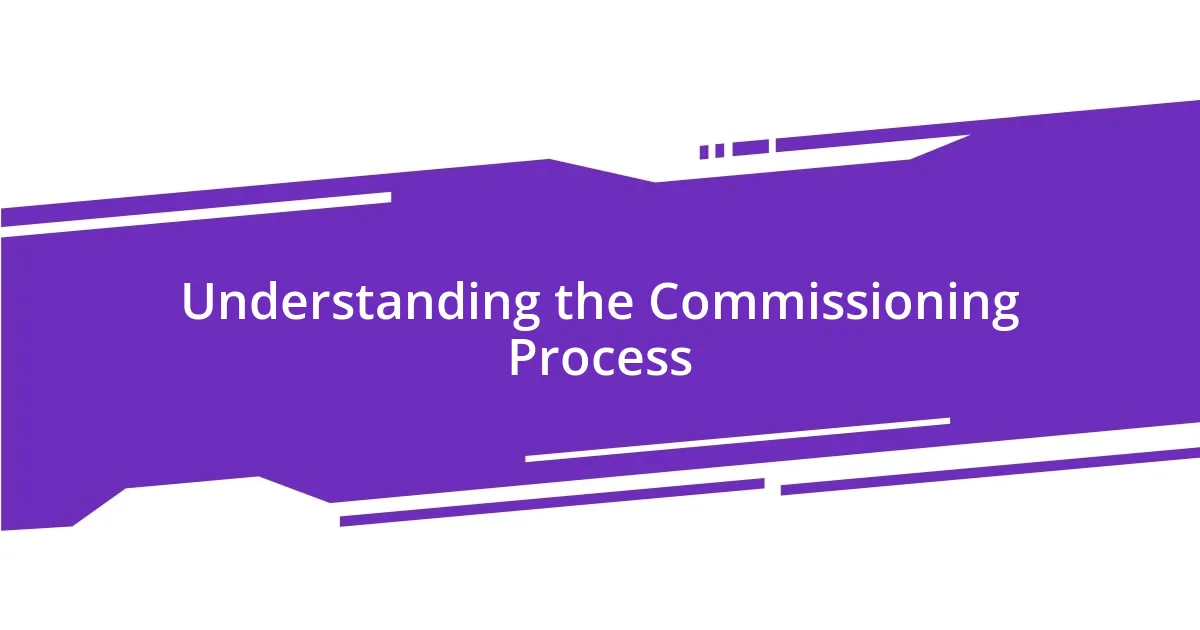Key takeaways:
- Choosing wall art involves expressing personal emotions and considering the aesthetic of your space.
- The commissioning process is collaborative, requiring clear communication of your vision and practical details.
- Establishing a realistic budget is essential to align your financial expectations with the artist’s skills and your art preferences.
- Effective feedback during drafts enhances the artwork, fostering a productive relationship with the artist and ensuring the final piece reflects your vision.

Choosing the Right Wall Art
Choosing the right wall art can feel overwhelming, but it’s truly an opportunity to express yourself. I remember standing in an art gallery, surrounded by vibrant colors and intricate designs, trying to imagine how each piece would look in my living room. Have you ever found yourself lost in thought over what a piece could say about you or your space?
Think about the emotions you want your art to evoke. For instance, I once commissioned a piece that incorporated soft blues and greens—a reflection of my love for the ocean. Each time I glance at that artwork, it transports me to a serene beach, reminding me of my cherished memories. How do you want your chosen pieces to resonate with your personal experiences or the atmosphere in your home?
It’s also essential to consider your space’s aesthetic. When I was selecting art for a cozy corner of my office, I realized I needed something that complemented the warm woods and natural light. Opting for a piece that mirrored these elements not only enhanced the ambiance but also made the area feel more inviting. So, what elements of your home are calling for a creative touch?

Understanding the Commissioning Process
Understanding the commissioning process of custom wall art is crucial to creating a piece that truly resonates with you. I recall my first experience; I was nervous but also excited. Reconciling my vision with the artist’s expertise felt daunting. It wasn’t just about picking a style or a color; it was about collaborating on something that would tell my story.
Here are some key steps in the commissioning process to consider:
- Find the Right Artist: Research different artists whose styles you admire. I spent countless evenings browsing portfolios online, looking for someone who shared my artistic vision.
- Communicate Your Vision: Once I connected with an artist, I shared my ideas and inspirations. I found that giving examples and being open to their input paved the way for a richer conversation.
- Discuss Practical Details: Talk about size, materials, and your budget. During my discussions, we explored how certain materials would enhance the overall look and feel.
- Set Clear Expectations: Outline a timeline and any milestones for progress. In my case, establishing check-in points helped keep the excitement alive.
- Trust the Process: Be open to adjustments along the way. The artist proposed a few changes that ultimately improved the piece, giving me new insights into their creative process.
Embracing each step not only eased my concerns but also deepened my respect for the artistry involved. The final piece wasn’t just a decoration; it became a true reflection of who I am—crafted through a beautiful collaboration.

Finding the Right Artist
Finding the right artist for your custom wall art is a journey worth taking. I remember scrolling through countless artist profiles, feeling a mix of excitement and uncertainty. It’s all about finding someone whose style resonates with your vision. Ask yourself, what qualities do I want in an artist? For me, it was essential to discover someone who not only created beautiful work but also understood my story.
As I delved deeper into this search, I learned to appreciate the artistic process behind each creator. I once stumbled upon an artist whose colorful abstract work reminded me of my travels. Reaching out and discussing my vision was a pivotal moment! Through our chat, I realized that I wanted my art to embody the vibrancy of life itself, an emotional reflection I hoped to celebrate in my home.
Let’s not forget the importance of communication. When I found my artist, I made sure to share my inspirations and ideas openly. This exchange wasn’t just about personal preferences; it became an enriching dialogue that shaped the final piece into something truly meaningful. Have you ever felt that connection with someone over shared creative visions? It can lead to incredible outcomes!
| Criteria | Considerations |
|---|---|
| Artistic Style | Does it resonate with your vision? |
| Portfolio | Are you inspired by their previous work? |
| Communication | Can you easily share your ideas and connect? |
| Experience | What is their background or specialties? |

Communicating Your Vision Clearly
Communicating your vision clearly is essential when commissioning custom wall art. I learned this firsthand when I was drafting my ideas for a piece that would hold a special place in my heart. I started by jotting down my thoughts, specific themes, and colors that resonated with my emotional journey, which served as a solid foundation for our discussions.
During my conversations with the artist, I realized it was important to share not just visual elements but also the feelings behind them. For instance, I explained how certain hues reminded me of childhood memories spent in my grandmother’s garden. It’s interesting how opening up about those emotional connections allowed the artist to capture the essence of my vision more accurately. Do you think about how personal stories can breathe life into a piece of art? It’s truly transformative.
I also discovered that visual aids could bridge any gaps in communication. I sent along images of similar works and even some color swatches that sparked my imagination. This approach opened up a captivating dialogue, where I could see my ideas evolving in real-time. In the end, I felt like we were both on this journey together, making the entire process feel collaborative and enriching.

Establishing a Realistic Budget
Establishing a realistic budget is crucial when commissioning custom wall art. Early on, I found myself wrapped up in the excitement of creating a unique piece but realized I needed to ground my expectations. Setting a budget helped me identify not just what I could afford, but also what I genuinely valued in the art-making process.
When I first considered a commission, I had a figure in my mind that seemed feasible. However, as I explored various artists and styles, it became clear that prices varied significantly. For instance, an artist renowned for intricate detail and established presence commanded higher fees. I had to ask myself: What am I willing to invest for a piece that will truly enrich my space? This reflection guided me toward a budget that felt both realistic and respectful of the artist’s time and skills.
Sometimes, I think budgeting can feel daunting, but it’s really about prioritization. I had to weigh how much I wanted to allocate toward this art versus my other expenses. By creating a tiered budget—allocating a little more for exceptional pieces or unique materials—I managed to find a balance that allowed me to pursue my passion while staying financially responsible. Have you ever navigated a similar budgeting dilemma? It can feel overwhelming, but it’s all part of the creative journey!

Reviewing Drafts and Feedback
When it came to reviewing drafts, I found this stage to be one of the most exhilarating yet nerve-wracking parts of commissioning custom wall art. My first draft came in, and I couldn’t help but feel a mix of excitement and apprehension. Was the artist capturing the essence of my vision? That initial feedback session was vital; it was my chance to express my thoughts and feelings about the piece. I remember pointing out a color that didn’t quite resonate with me, sharing how it invoked a sense of unease instead of the tranquility I intended. That openness led to tweaks that made all the difference.
Providing feedback isn’t just about pointing out what needs adjusting; it’s also about acknowledging what I loved. The first draft revealed beautiful details that truly caught my eye, and I made sure to highlight those during our discussions. I expressed how the interplay of light in a specific section transported me back to serene mornings in a sunlit meadow. Don’t you think recognizing and celebrating the successes in drafts encourages artists? It fosters a more collaborative spirit and encourages them to dig deeper into their creative process.
As we moved through each iteration, I made a conscious effort to keep my feedback concise yet thorough. I learned that it’s easy to become overwhelmed by wanting to change multiple aspects, but focusing on one or two key elements allowed for clearer communication. I shared my thoughts on where I envisioned a different texture or how I wanted the composition to flow. It felt rewarding to refine our mutual understanding over several drafts, transforming my vision into something tangible, something that felt authentically ‘me.’ Have you experienced that moment where a feedback exchange leads to a true masterpiece? It’s where you realize how much collaboration enhances the creative journey.

Final Installation Tips
When it was finally time to install my custom wall art, I realized preparation was everything. I made sure to gather all the necessary tools beforehand—level, tape measure, and a soft cloth for any adjustments. But something I didn’t anticipate was the emotional rush of seeing my artwork go from concept to reality. Have you felt that thrill when transforming a vision into something tangible? It’s truly rewarding!
I discovered early on that choosing the right height for hanging the piece was crucial. In my experience, eye level is usually about 57-60 inches from the floor, which seemed perfect to engage with the art. I remember standing back and adjusting the piece multiple times, each shift sparking new thoughts. Would this placement encourage conversation? The moment it felt just right, it was as if the artwork breathed life into the room, and I couldn’t help but smile. Isn’t it fascinating how a single piece can change the entire atmosphere of a space?
Lastly, I can’t stress enough how important it is to step back and assess the overall aesthetic once the piece is hung. After installation, I took a moment to sit on my couch and just absorb the artwork in its new home. The colors danced with the natural light, and suddenly, I saw new details I hadn’t noticed before. Have you ever experienced that kind of surprise after you thought the process was complete? It made me appreciate my decision even more, confirming that the time and effort I invested in commissioning this piece truly enriched my environment.














